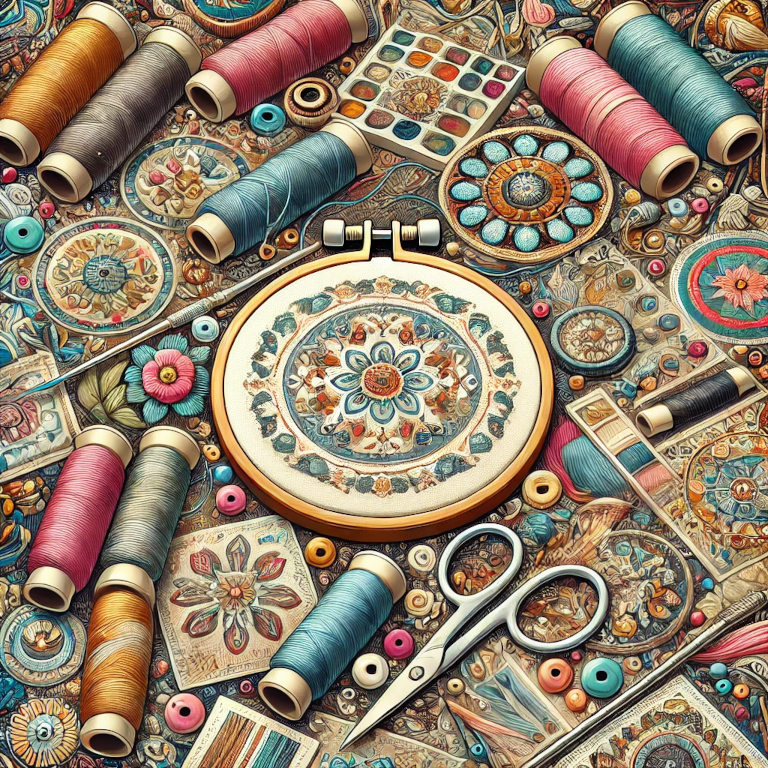Beadwork and embroidery are two timeless crafts that offer endless possibilities for creativity and personal expression. These intricate art forms allow individuals to create beautiful, handcrafted pieces that reflect their unique style and craftsmanship. As an expert in DIY and Crafts, this article will delve into the fascinating world of beadwork and embroidery, exploring their history, techniques, and tips for getting started.
The Art of Beadwork
Beadwork involves stitching or weaving beads together to create decorative items, jewelry, or embellishments for clothing and accessories. This craft has been practiced for thousands of years across various cultures, each contributing unique styles and techniques.
History of Beadwork
Beadwork dates back to ancient civilizations, where beads were made from natural materials like shells, stones, and bones. These early beads were used for personal adornment, ceremonial purposes, and trade. Over time, bead-making techniques evolved, and beads were crafted from glass, metal, and synthetic materials, allowing for more intricate designs and widespread use.
Techniques in Beadwork
- Stringing: This is the simplest form of beadwork, involving threading beads onto a string or wire to create necklaces, bracelets, and other jewelry items.
- Loom Beading: This technique uses a loom to create patterned beadwork, often used for belts, straps, and decorative panels.
- Peyote Stitch: A versatile and popular stitch, peyote involves weaving beads together in a staggered pattern, creating a flexible and textured fabric.
- Brick Stitch: Similar to peyote, the brick stitch involves weaving beads in a pattern that resembles a brick wall. This technique is often used for creating detailed patterns and images.
- Bead Embroidery: Beads are sewn onto fabric using various stitches, adding dimension and sparkle to garments, accessories, and home decor items.
The Craft of Embroidery
Embroidery is the art of decorating fabric or other materials using a needle to apply thread or yarn. This craft has a rich history and diverse techniques that have been passed down through generations, making it a cherished and versatile form of artistic expression.
History of Embroidery
Embroidery has been practiced for centuries, with evidence of embroidered garments and textiles found in ancient Egypt, China, and Greece. Initially, embroidery was a symbol of wealth and status, as the intricate designs required significant time and skill. Over time, the craft became more accessible, and various cultures developed their own distinctive styles and techniques.
Techniques in Embroidery
- Cross-Stitch: One of the most popular forms of embroidery, cross-stitch involves creating X-shaped stitches to form a pattern or image on fabric.
- Satin Stitch: This technique uses long, smooth stitches to fill in shapes, creating a satin-like finish that adds a rich texture to the design.
- Backstitch: A basic and versatile stitch, backstitch is often used for outlining shapes and adding fine details to embroidery projects.
- French Knot: This decorative stitch involves wrapping the thread around the needle and pulling it through the fabric to create small, raised knots that add texture and dimension.
- Appliqué: Involves sewing pieces of fabric onto a larger fabric base to create designs. This technique is often combined with other embroidery stitches for added detail and texture.
Getting Started with Beadwork and Embroidery
For beginners looking to explore beadwork and embroidery, here are some essential tips and materials to get started:
Essential Tools and Materials
- Beadwork:
- Beads: Choose from a variety of sizes, shapes, and materials, such as seed beads, glass beads, and gemstone beads.
- Needles: Beading needles are thin and flexible, allowing them to pass through small bead holes multiple times.
- Thread: Use strong, durable thread like nylon or FireLine for beading projects.
- Loom: If you plan to try loom beading, a bead loom is essential.
- Findings: Clasps, jump rings, and earring hooks are necessary for finishing jewelry pieces.
- Embroidery:
- Fabric: Choose a fabric suitable for your project, such as cotton, linen, or canvas.
- Needles: Embroidery needles come in various sizes; choose one that matches your thread and fabric.
- Thread: Embroidery floss is available in a wide range of colors and is often used in multiple strands for different effects.
- Hoops: Embroidery hoops hold the fabric taut while you work, ensuring even stitches.
- Scissors: Sharp embroidery scissors are essential for cutting thread and fabric accurately.
Tips for Success
- Start Simple: Begin with easy projects to build your confidence and skills. Simple patterns and designs are perfect for beginners.
- Practice Patience: Both beadwork and embroidery require patience and attention to detail. Take your time and enjoy the process.
- Learn from Tutorials: Online tutorials, videos, and classes can provide valuable guidance and inspiration.
- Experiment with Techniques: Don’t be afraid to try different stitches and methods to find what you enjoy most.
- Keep Supplies Organized: Organize your beads, threads, and tools to make your crafting process more efficient and enjoyable.
Summary
Beadwork and embroidery are timeless crafts that offer endless opportunities for creativity and personal expression. By exploring the history, techniques, and practical tips for these art forms, you can embark on a fulfilling journey of crafting beautiful, handcrafted pieces. Whether you’re a beginner or an experienced crafter, beadwork and embroidery provide a rewarding way to enhance your DIY and craft skills.






